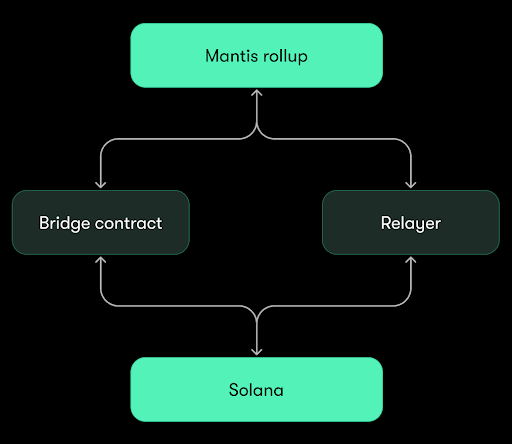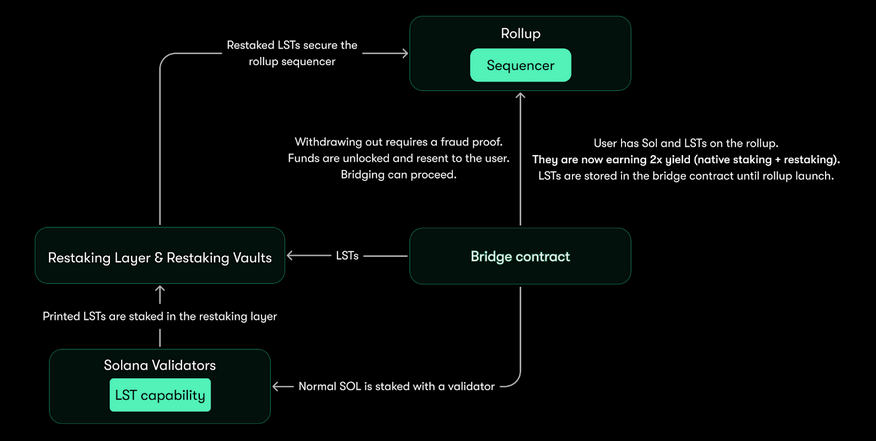By 0xbrainjar
This article is a part of a series of articles discussing what Mantis believes a rollup on SVM requires. In this series, we explore the different components that we needed to architect for the Mantis rollup.
Summary
In this particular article, I describe the bridge contract, which has a critical role in bridging assets to and from the Mantis rollup. Specifically, I discuss the process of depositing in the bridge contract, the types of yield this can generate, the withdrawal process, and the role of the bridge contract in transaction execution.
Bridge Contract
Purpose
The bridge contract interacts with the rollup to facilitate bridging.
Communication Between the L1 and L2
In this design, the bridge contract is used to move assets between Mantis (the L2) and its L1, Solana. This occurs over the Inter-Blockchain Communication (IBC) Protocol. The bridge contract connects to an IBC contract to facilitate this connection. A relayer is also used to send information between the Mantis rollup and Solana:

Deposits
Any asset can be deposited into the bridge contract to be staked in proof-of-stake validation and provide staking rewards. Deposits of SOL or any of a number of liquid staked tokens (LSTs) from SOL earn additional yield in the form of restaking, DeFi integrations, and native yield:
Restaking
Accepted assets: SOL and SOL-based LSTs
SOL deposited into the Mantis bridge contract is staked with Solana validators for proof-of-stake validation in Picasso’s Restaking Layer. Staked SOL will be represented by an LST. Users can then choose to also restake their LSTs into the Solana Restaking Layer. This provides doubled staking yield while abstracting away the additional steps for users to perform restaking on their own.
Any LSTs that have been directly deposited into the bridge contract also flow to the restaking vault. The resulting crypto-economic security can be leveraged by the Mantis rollup and other Actively Validated Services (AVSes) paying for this security.
Tokens that have been restaked in this Restaking Layer will be used to secure the sequencers of the Mantis Solana-based rollup.
DeFi Integrations
Accepted assets: SOL-based LSTs and Solana native stablecoins
LSTs generated from staking SOL via the bridge contract are deposited into lending protocols, initially marginfi. This provides the user with additional yield.
Any Solana-native stablecoins deposited into the bridge contract will also be routed to these lending protocols. The user can then choose to restake their stablecoins into the Solana restaking layer. This also results in double yield for the user.
Native Yield
Accepted assets: SOL or any assets in Mantis Accounts on the Mantis rollup
Users can stake SOL tokens directly into mantis.app. These SOL are then delegated on the backend to Solana validators. This will allow users to accrue native yield, just as they normally would from using their SOL for proof-of-stake validation on Solana. Users will also receive an LST to represent their SOL stake. Users will earn additional rewards from opting into restaking this LST. This enhances their overall yield from the same amount of underlying assets.
Mantis Accounts also facilitate native yield for other asset types. Mantis Accounts are network-level accounts that can be used for participating in on-chain actions. Mantis Account users will earn native yield for any assets deposited to the Mantis rollup from their account. Therefore, assets held in Mantis Accounts earn yield even when not actively being used.
Native staking and restaking in Mantis can be combined in the Mantis framework streamlining the (re)staking process for users:

Withdrawals
Withdrawals of (re)staked tokens are done as IBC transfers. Funds are unlocked and sent back to the user in the form in which they were deposited. For example, if a user deposited SOL, SOL will be returned to them. The user can then bridge their tokens to other locations or perform other functionalities with them again over IBC.
Role in Transaction Flow
The bridge contract also has a role in transaction flow on Mantis: it sends blocks of transactions from Mantis out over IBC to destination chains for settlement. Complete details on how the IBC is used in Mantis are available in this post.
To summarize this overall flow, validators of the rollup also act as block builders. The blocks of Mantis rollup transactions are picked up by the sequencer on Mantis. The sequencer sends blocks to the bridge contract, which subsequently sends transactions out over IBC using a light client that we have created between L1 and L2. Via the IBC, blocks of transactions post to the final layer 1.